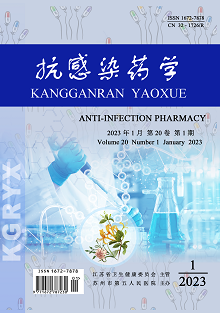DONG Chun-ping, WU Ding-hui, YANG Ying-hui, YAO Xiang-yang
Objective: To investigate the drug resistance of tuberculosis patients to 4 common first-line anti-tuberculosis drugs of isoniazid (INH), rifampin (RFP), streptomycin (SM) and ethambutol (EMB), and provide reference for anti-tuberculosis treatment of tuberculosis patients. Methods: A total of 2 126 tuberculosis patients admitted to the First Affiliated Hospital of Xiamen University from January 2016 to December 2020 were selected as the subjects, and the clinical data of patients such as gender, age, resistance to the four first-line anti-tuberculosis drugs (INH, RFP, SM and EMB) were collected, to investigate the current situation and characteristics of drug resistance of tuberculosis patients. Results: From 2016 to 2020, 531 of the 2 126 tuberculosis patients were resistant to first-line anti-tuberculosis drugs (the drug resistance rate was 24.98%), and the drug resistance rate fluctuated little in each year (P>0.05); among the 2 126 tuberculosis patients, the drug resistance rate of male patients to first-line anti-tuberculosis drugs was higher than that of female patients (26.32% vs 21.62, P<0.05); through comparison, there was a significant difference in the rate of drug resistance to first-line anti-tuberculosis drugs among tuberculosis patients at different ages (P<0.05), among which, the drug resistance rate was the highest in patients at 40+ to 60 years old (28.21%), and the drug resistance rate was the lowest in patients at no more than 20 years old (18.99%). Among the 531 drug-resistant tuberculosis patients, their drug resistance rates to INH and SM were high (15.67% and 15.29%, respectively), while their drug resistance rate to EMB was the lowest (4.61%). Among the 531 drug-resistant tuberculosis patients, the ratio of patients who were resistant to only one first-line anti-tuberculosis drug was the highest (48.59%), while the ratio of patients who were resistant to 3 or 4 drugs was low (17.70% and 12.05%, respectively). Among the 531 drug-resistant tuberculosis patients, the main drug-resistant types were monodrug-resistant tuberculosis (258 cases, 48.59%) and multidrug-resistant tuberculosis (214 cases, 40.30%). Among patients with monodrug-resistant tuberculosis, the drug resistance was mainly to SM (139 cases, 26.18%); among patients with multidrug-resistant tuberculosis, there were many patients who were resistant to INH+RFP+SM, INH+RFP+SM+EMB and INH+RFP, 69 cases (12.99%), 64 cases (12.05%) and 58 cases (10.92%) respectively. Conclusion: At present, the drug resistance of tuberculosis patients to the first-line anti-tuberculosis drugs is still in a severe situation in Xiamen, and the multidrug-resistance is serious. Clinical management of standardized treatment of tuberculosis patients should be further strengthened to reduce the occurrence of drug resistance as much as possible.
